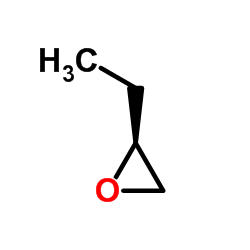(2R)-2-Ethyloxirane

(2R)-2-Ethyloxirane structure
|
Common Name | (2R)-2-Ethyloxirane | ||
|---|---|---|---|---|
| CAS Number | 30608-62-9 | Molecular Weight | 72.106 | |
| Density | 0.9±0.1 g/cm3 | Boiling Point | 63.4±0.0 °C at 760 mmHg | |
| Molecular Formula | C4H8O | Melting Point | N/A | |
| MSDS | Chinese USA | Flash Point | -12.2±0.0 °C | |
| Symbol |




GHS02, GHS05, GHS07, GHS08 |
Signal Word | Danger | |
|
Aqueous-phase aminolysis: approach for the analysis of epoxides in water.
Anal. Chem. 78(8) , 2608-2616, (2006) Trace concentrations of small soluble epoxides are suspected byproducts of drinking water ozonation. However, adequate characterization of epoxide formation is currently limited by the lack of suitable analytical methods to target these chemicals in dilute, b... |
|
|
Comparative mutagenicity of structurally related aliphatic epoxides in a modified Salmonella/microsome assay.
Mutagenesis 8(5) , 387-93, (1993) Four structurally related aliphatic epoxides (1,2-epoxypropane, 1,2-epoxyisobutane, cis- and trans-2,3-epoxybutane) have been tested in the Salmonella/microsome assay, modified for volatile substances, using the strains TA1535 and TA100. The aim of the study ... |
|
|
Encephalomyeloradiculoneuropathy following exposure to an industrial solvent.
Clin. Neurol. Neurosurg. 101(3) , 199-202, (1999) A 19-year-old male developed complaints including weakness of the lower extremities and right hand, numbness, dysphagia and urinary difficulties following a 2 month exposure to an industrial solvent constituted mainly of 1-bromopropane, but also containing bu... |
|
|
Carcinogenicity study of trichloroethylene, with and without epoxide stabilizers, in mice.
J. Cancer Res. Clin. Oncol. 107(3) , 149-56, (1984) Previous analytical studies of industrial samples of trichloroethylene (TRI) have revealed the presence of mutagenic and carcinogenic epoxides which, it was proposed, might be responsible for the carcinogenicity of such samples, as demonstrated with mice in o... |
|
|
Effects of aqueous polymeric surfactants on silicone-hydrogel soft- contact-lens wettability and bacterial adhesion of Pseudomonas aeruginosa.
Cont. Lens Anterior Eye 35(4) , 155-62, (2012) Prevention of Pseudomonas aeruginosa binding to soft-contact lenses (SCLs) may curtail sight-threatening microbial keratitis. Substrate surface wettability is known to modulate adhesion of P. aeruginosa. This study investigates the use of aqueous alkoxylate b... |
|
|
Solubilisation of griseofulvin in aqueous micellar solutions of diblock copolymers of ethylene oxide and 1,2-butylene oxide with lengthy B-blocks
Int. J. Pharm. 369(1-2) , 196-8, (2009) The influence of hydrophobic-block length on solubilisation capacity was examined for micelles of E m B n copolymers (E = oxyethylene, B = oxybutylene, subscripts denote number-average block lengths in repeat units) with B-block lengths in the range of 30–76 ... |
|
|
Respiratory tract lesions in F344/N rats and B6C3F1 mice after inhalation exposure to 1,2-epoxybutane.
Toxicology 50(1) , 69-82, (1988) 1,2-Epoxybutane, a short-chain epoxide used as a stabilizer in chlorinated hydrocarbon solvents, was administered by inhalation exposure as a vapor 6 h/day, 5 day/week, for 24 months at exposure concentrations of 0, 200 or 400 ppm to F344/N rats and 0, 50, or... |
|
|
Polyneuropathy due to ethylene oxide, propylene oxide, and butylene oxide.
Environ. Res. 60(2) , 242-7, (1993) Axonal neuropathy occurs due to occupational ethylene oxide (EtO) exposure. The experimental model of human EtO neuropathy was established. In addition, the neurotoxic effects of propylene oxide (PpO) and butylene oxide (BtO) were demonstrated in rats. Althou... |
|
|
Quantitative determination of 1,2-butylene oxide in whole rat blood by gas chromatography-mass spectrometry.
J. Chromatogr. A. 398 , 347-50, (1987)
|
|
|
Epoxidation of 1-butene-3-ol over titanium silicalite TS-2 catalyst under autogenic pressure.
J. Hazard. Mater. 163(2-3) , 1303-9, (2009) Epoxidation of 1-butene-3-ol (1B3O) with 30 wt% hydrogen peroxide over TS-2 catalyst has been studied with methanol as a solvent and at elevated pressure (autogenic). The influence of temperature in the range of 20-120 degrees C, the molar ratio of 1B3O/H(2)O... |